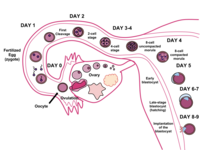
Photo from wikipedia
Cadherins play an essential role in the attachment of the blastocyst to the endometrium, a process known as endometrial receptivity. Loss of E-cadherin expression is essential during the process, while… Click to show full abstract
Cadherins play an essential role in the attachment of the blastocyst to the endometrium, a process known as endometrial receptivity. Loss of E-cadherin expression is essential during the process, while the expression level of the other cadherin, N-cadherin, has been reported to be altered in cases of infertility. Both E-cadherin and N-cadherin can be regulated by members of the PARP family. Specifically, PARP-2, which is under the epigenetic control of miR-149, has been observed to promote E-cadherin expression in other human cells. We investigated the roles of E-cadherin and N-cadherin in endometrial receptivity using mouse models for normal endometrial receptivity, pseudopregnancy, and LPS-induced endometrial receptivity failure. E-cadherin and phosphorylated E-cadherin were predominantly expressed during pre-receptive stages as well as in the implantation site of the receptive stage, which were observed reduced during the later stages of implantation in both implantation and non-implantation regions, while N-cadherin was detected only at pre-receptive stages. E-cadherin and N-cadherin were also seen in the uterus during pseudopregnancy, showing a downregulation trend during receptive and post-receptive stages. LPS-induced failed endometrial receptivity showed upregulation of E-cadherin and downregulation of N-cadherin. The E-cadherin expression promoter, GSK-3, was lost and its suppressor, SLUG was upregulated during normal course of endometrial receptivity in mouse model, while GSK-3 was increased during LPS-induced failed embryo implantation. In an in vitro model of embryo implantation, E-cadherin expression is promoted by PARP-2 and regulated by miR-149 epigenetically in human endometrium epithelial cells. In conclusion, E-cadherin is predominantly expressed during pre-receptive stage and promoted by PARP-2, which is regulated by miR-149 in the endometrial epithelial cells.
Journal Title: Reproductive Sciences
Year Published: 2021
Link to full text (if available)
Share on Social Media: Sign Up to like & get
recommendations!